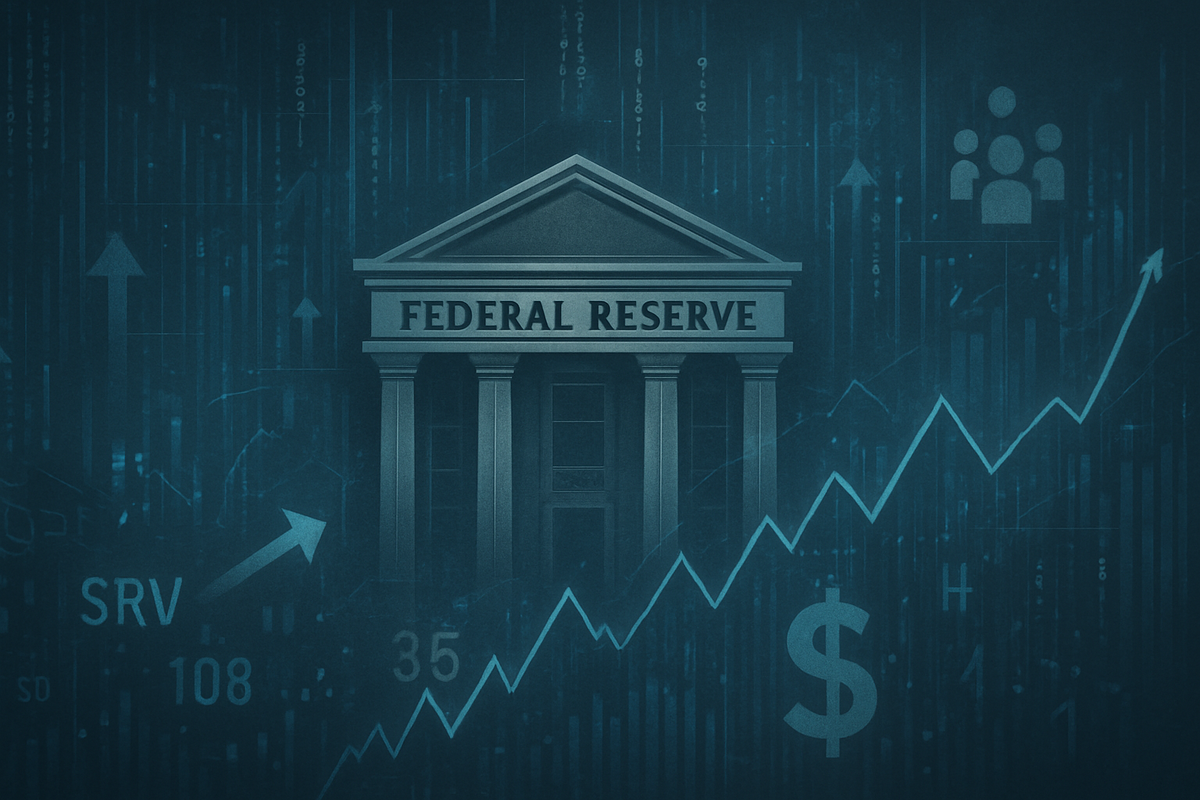Markets Brace for Fed Data Deluge: Inflation and Jobs Reports Set to Define Year-End Monetary Policy

As November 2025 draws to a close, financial markets are gripped by a palpable sense of anticipation, with traders keenly awaiting a series of crucial data releases from the Federal Reserve and related agencies. This heightened focus is amplified by recent government shutdown-induced delays, which have created a backlog of vital economic indicators. The forthcoming figures, particularly those pertaining to inflation and the labor market, are poised to offer critical insights into the health of the U.S. economy and, more importantly, to heavily influence the Federal Reserve's monetary policy trajectory, especially regarding potential interest rate adjustments in the crucial December meeting. The immediate implication is a landscape of elevated market volatility, as investors attempt to decipher the Fed's next move.
A Torrent of Data Amidst Policy Uncertainty
The past week has seen a steady drip of significant economic information, with more on the horizon, creating a complex puzzle for analysts. The Federal Open Market Committee (FOMC) meeting minutes from October 28-29, released on November 19, provided an initial glimpse into the committee's internal discussions and policy leanings. This was swiftly followed by the much-delayed September employment situation report, finally published on Thursday, November 20. The report indicated a softer U.S. jobs market, adding 119,000 jobs, with the unemployment rate ticking up to 4.4%. While the standalone October jobs report remains elusive, the Bureau of Labor Statistics (BLS) plans to integrate these figures with November's data for a December release, adding to the suspense. Weekly jobless claims for the period ending November 21 are also due on Wednesday, November 26, offering a more granular, up-to-date view of labor market dynamics.
Inflation metrics, the Fed's primary concern, are also central to market anxieties. The Producer Price Index (PPI) for September was scheduled for release on Tuesday, November 25, providing a wholesale inflation gauge that often foreshadows consumer price trends. More critically, the Personal Consumption Expenditures (PCE) Index, the Federal Reserve's preferred inflation measure, for October, was originally slated for November 26. However, reports suggest that limited October price numbers will now be bundled with November data for a December 18 release, alongside the delayed October Consumer Price Index (CPI). These delays have intensified the scrutiny on any available inflation signals.
Further economic barometers include the U.S. Manufacturing and Services Purchasing Managers' Indexes (PMI) for November, announced on November 21, and the Chicago PMI due on November 26. The Federal Reserve's Beige Book, a qualitative summary of economic conditions across its twelve districts, is also expected on November 26, offering anecdotal evidence to complement the quantitative data. Additional releases this week include the Chicago Fed National Activity Index (CFNAI) and Survey of Economic Conditions (CFSEC) on November 24, along with September retail sales figures and delayed September durable goods orders, both scheduled for November 26. Each piece of data, whether signaling economic strength or weakness, is being meticulously analyzed for its implications on the Fed's interest rate path, fostering significant volatility across the US dollar, Treasury yields, and equity markets.
Corporate Fortunes Hang in the Balance
The Federal Reserve's monetary policy decisions, particularly those impacting interest rates, create a clear divide between potential winners and losers in the public markets. In an environment where the Fed is easing rates, typically to stimulate a slowing economy, Technology & Growth Stocks tend to thrive. Companies like NVIDIA (NASDAQ: NVDA), Microsoft (NASDAQ: MSFT), and Alphabet (NASDAQ: GOOGL) benefit significantly as lower discount rates enhance the present value of their future earnings, and cheaper borrowing costs fuel innovation and expansion. Similarly, the Real Estate sector, including homebuilders like D.R. Horton (NYSE: DHI) and construction suppliers like Builders FirstSource (NYSE: BLDR), along with various REITs, sees increased demand as lower mortgage rates make homebuying more affordable and reduce financing costs for new projects. Consumer Discretionary companies such as Tesla (NASDAQ: TSLA), Walt Disney (NYSE: DIS), Royal Caribbean Group (NYSE: RCL), and Carnival Corp. (NYSE: CCL) also stand to gain from increased consumer disposable income. Utilities like Eversource Energy (NYSE: ES) and American Electric Power (NASDAQ: AEP), being capital-intensive, benefit from reduced borrowing costs for infrastructure investments.
Conversely, in a scenario where interest rates remain elevated or are raised to combat persistent inflation—a possibility if upcoming data surprises on the upside—certain sectors face headwinds. Highly Leveraged Businesses across all sectors, including some in transportation or manufacturing, would see increased borrowing costs erode profitability. While financial institutions like JPMorgan Chase (NYSE: JPM), Bank of America (NYSE: BAC), and Goldman Sachs (NYSE: GS) generally benefit from wider net interest margins in a rising rate environment, an overly restrictive policy could stifle overall economic activity, eventually impacting loan demand. For Real Estate, higher mortgage rates can deter homebuyers, negatively affecting homebuilders like Lennar (NYSE: LEN) and REITs such as Simon Property Group (NYSE: SPG). High-growth tech companies, especially those not yet profitable, could see their valuations pressured as future earnings are discounted more heavily. Investors are thus carefully positioning their portfolios, seeking resilience and opportunity amidst the Fed's evolving stance.
Broader Implications and Historical Echoes
The Federal Reserve's current monetary policy, characterized by recent interest rate cuts and a cautious easing stance, is deeply interwoven with several broader industry trends. The U.S. economy is projected to slow into Q4 2025, with consumer spending, though resilient, expected to weaken. Inflation, however, remains stubbornly above the Fed's 2% target, partly due to the reintroduction and staggered rollout of tariffs. Simultaneously, the labor market is gradually cooling, with the unemployment rate rising. This complex backdrop is contrasted by a significant and potent growth catalyst: the Artificial Intelligence (AI) investment boom. Companies are pouring capital into AI tools and solutions, driving efficiency and creating new jobs, preventing a more severe economic slowdown. This trend means that even as traditional economic indicators soften, high-tech investment continues to buoy parts of the market.
The ripple effects of the Fed's policy are widespread. Lower interest rates, if sustained, are likely to translate into lower yields on money market funds, potentially driving investors towards equities and bonds in search of higher returns. Businesses reliant on debt will benefit from reduced borrowing costs, freeing up capital for growth initiatives, hiring, and debt reduction. This could spur increased IPO activity and M&A, benefiting capital markets firms. The Tech Sector, particularly high-growth areas like AI and semiconductors, remains highly sensitive to monetary policy; a "higher for longer" rate environment or delays in expected cuts disproportionately impact companies whose valuations rely on long-term growth and significant capital expenditure, affecting competitors like Advanced Micro Devices (NASDAQ: AMD) and Intel (NASDAQ: INTC) and the broader semiconductor supply chain. Globally, Fed policy significantly influences foreign exchange markets; an easing cycle tends to narrow yield differentials, affecting currencies like the Euro and Japanese Yen, and making emerging market currencies particularly sensitive due to dollar-denominated debt.
Regulatory and policy implications are also significant. The Federal Reserve Board is conducting a periodic review of its monetary policy strategy, tools, and communications in 2025, which will shape future responses to economic challenges. Discussions around bank regulation and the Fed's balance sheet size, with suggestions like exempting Treasuries from banks' leverage ratios, aim to protect financial stability. Furthermore, the recent 43-day government shutdown, which caused an unprecedented "data blackout," has underscored persistent fiscal instability and raised concerns about elevated U.S. interest costs and widening deficits. This event has also accelerated a trend towards businesses relying more on private-sector data sources for real-time economic insights. Historically, the Fed's aggressive rate hikes from 2022 to early 2025 are comparable to the Volcker era of the 1970s and 80s, demonstrating the Fed's commitment to price stability. The current challenge of managing sticky inflation alongside a cooling labor market revives debates around the Phillips Curve, with the Fed aiming to avoid past policy mistakes.
Navigating the Path Ahead: Scenarios and Strategic Pivots
The coming months present a complex and potentially volatile period for financial markets, as the Federal Reserve navigates its dual mandate amidst conflicting economic signals. In the short term, the primary focus remains the December 9-10, 2025, FOMC meeting. While there's a "sharp division" among officials, market probabilities for another 25-basis-point rate cut have recently rebounded to approximately 65-70%, fueled by dovish comments from New York Fed President John Williams and Governor Christopher Waller. Alternatively, a "dovish hold" – maintaining rates but signaling future cuts – remains a possibility, allowing the Fed to gather more complete economic data post-shutdown. The delayed Producer Price Index (PPI) for September, expected on November 25, will be the last significant inflation gauge before the December meeting, making its release particularly impactful.
Long-term possibilities point towards a continued easing path. Goldman Sachs Research and J.P. Morgan anticipate two to three additional rate cuts into 2026, bringing the federal funds rate to a terminal range of 3.00%-3.25%. Inflation is projected to remain somewhat elevated in the near term, partly due to tariff effects, before gradually converging to the Fed's 2% target by 2027. The Fed's balance sheet strategy will also evolve, with the planned launch of Quantitative Easing (QE) in January 2026, transitioning to an "ample reserves" framework to maintain banking system liquidity.
Strategic pivots will be paramount for both the Fed and market participants. The Fed's decisions will remain highly data-dependent, requiring constant adaptation to incoming information on inflation and employment. If inflation proves stubbornly high or the labor market deteriorates more rapidly than expected, the Fed may need to re-evaluate its easing pace. For businesses, this environment creates opportunities to aggressively refinance high-interest debt and pursue deferred capital investment projects due to lower borrowing costs. However, it also presents challenges of increased competition as cheaper capital encourages expansion. Market opportunities may emerge in growth equities and fixed income (increasing duration), while volatility will likely be a persistent challenge across all asset classes, including commodities and even Bitcoin (CRYPTO: BTC), which has historically shown sensitivity to accommodative monetary policy. Potential scenarios range from a "gradual easing" base case, supporting risk assets, to a "hard landing" requiring more aggressive cuts, or even "stagflation" demanding a defensive investor posture. The ideal "soft landing" remains the ultimate, albeit challenging, goal.
The Road Ahead: A Market in Flux
In summary, the Federal Reserve's monetary policy in late 2025 is a complex tapestry of recent rate cuts, the impending conclusion of quantitative tightening, and a data-dependent stance amidst persistent inflation and a softening labor market. The core takeaway is a central bank cautiously easing monetary conditions after a period of aggressive tightening, but with significant internal divisions and external uncertainties. The recent government shutdown has exacerbated this complexity, creating a "data blackout" that makes precise economic assessment challenging.
Moving forward, the market is poised for continued flux. Expectations for a December rate cut are volatile but leaning towards an easing, which, combined with the end of quantitative tightening on December 1, 2025, is expected to inject liquidity and potentially foster a "risk-on" sentiment. However, the stock market exhibits divergence, with high-growth tech stocks facing pressure while blue-chip companies with strong fundamentals show resilience. The lasting impact of tariffs, which are projected to keep inflation elevated through 2026, adds another layer of complexity, suggesting that a "higher for longer" interest rate environment may persist, potentially benefiting financial services companies and keeping long-term Treasury yields elevated due to America's rising debt.
Investors should remain vigilant in the coming months. Closely monitoring Federal Reserve communications, particularly the December FOMC meeting outcome and subsequent speeches, will be crucial. The delayed releases of inflation data (CPI, PCE, PPI) and labor market reports (unemployment rate, non-farm payrolls, wage growth) will provide critical guidance. The impact of tariffs on corporate earnings and consumer prices, along with broader market reactions to the end of quantitative tightening, warrants close attention. Finally, assessing corporate earnings and global economic developments will be essential for navigating this nuanced and evolving financial landscape.
This content is intended for informational purposes only and is not financial advice
More News
View More




Recent Quotes
View More
Quotes delayed at least 20 minutes.
By accessing this page, you agree to the Privacy Policy and Terms Of Service.